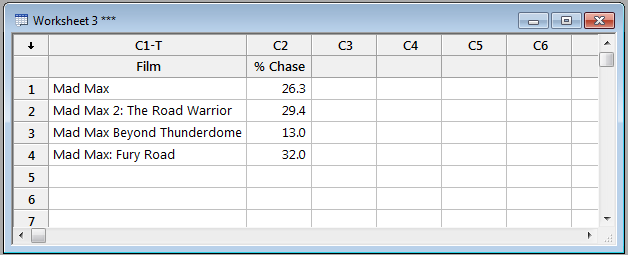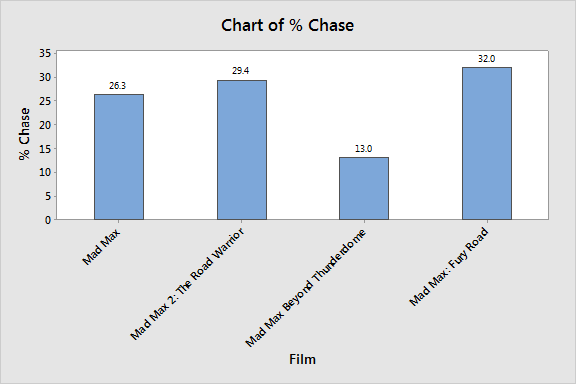By Matthew Barsalou, guest blogger.
Minitab Statistical Software can assist us in our analysis of data, but we must make judgments when selecting the data for an analysis. A good operational definition can be invaluable for ensuring the data we collect can be effectively analyzed using software.
Dr. W. Edwards Deming explains in Out of the Crisis (1989), “An operational definition of safe, round, reliable, or any other quality must be communicable, with the same meaning to vendor as to purchaser, same meaning yesterday and today to the production worker.” Deming goes onto to tell us an operational definition requires a specific test, a judgment criteria, and a decision criteria to determine if something met the criteria.
The concept of operational definitions crossed my mind when I read Todd VanDerWerff’s review of Mad Max: Fury Road at Vox.
VonDerWerff presented an illustration of the percent of time individual Mad Max movies contained a chase scene based on data from the Internet Movie Data Base. I have recreated the illustration below as a bar chart using Minitab.
I first typed the data into a Minitab worksheet as shown below:

I then stacked the data by going to Data > Stack > Columns… and selecting columns C1-C4. Next, I relabeled column C1-T as “Film” and column C2 as % Chase.”

Then I went to Graph > Bar Chart and selected “Values from a table” and a “Simple” bar chart. The graph variables were % Chase and the categorical variable was Film. I clicked on the resulting bar chart and then right clicked and selected Add > Data labels. The resulting bar chart is shown below:

As a connoisseur of the Mad Max series, I was rather shocked to see that Mad Max: Fury Road consisted of only 32% chase scenes. I would have estimated 95-95% chase scenes! VanDerWreff explains “We're skewing toward the conservative side here and only counting scenes where the characters are in the thick of a really contentious chase, where either side might prevail.” Obviously, we are using different criteria to identify a chase scene. VanDerWreff is close to an operational definition; however, “where either side might prevail” could still be open to interpretation and therefore, inadequate as an operational definition.
In Twenty Things you Need to Know (2009), Wheeler lists three questions that can serve as a framework for an operational definition:
- What do you want to accomplish?
- By what method will you accomplish your objective?
- How will you know you have accomplished your objective?
Answering Wheeler’s three questions can help us to define an operational definition for chase scenes in the latest Mad Max movie: We want to identify chase scenes in a Mad Max: Fury Road. We will use a calibrated stop watch capable of differentiating down to 1/100th of a second to identify the start and stop time of a chase where a chase is defined as “the time from when a chasing party first appears on screen at a range of 1,800 meters or less away from the chased party and the time will stop at the point where the chasing party is seen to be more than 1,800 meters away from the chased party or the last scene in which the chasing party appears.” The total chase time is to be divided by the total length of the movie and multiplied by 100. The objective will be accomplished after the last credit appears on the screen at the end of the movie.
Such a simple operational definition makes it clear what should be considered a chase scene. Notices that the operational definition refers to “chased parties” and not “chased vehicles”? This operational definition would include foot chases as chase time. Without an operational definition, one evaluator may include foot chases while another ignores them.
Tina Turner tells us, “We don’t need another hero.” Perhaps, but what we do need is a good operational definition if we want to correctly collect data for a statistical analysis.
About the Guest Blogger
Matthew Barsalou is a statistical problem resolution Master Black Belt at BorgWarner Turbo Systems Engineering GmbH. He is a Smarter Solutions certified Lean Six Sigma Master Black Belt, ASQ-certified Six Sigma Black Belt, quality engineer, and quality technician, and a TÜV-certified quality manager, quality management representative, and auditor. He has a bachelor of science in industrial sciences, a master of liberal studies with emphasis in international business, and has a master of science in business administration and engineering from the Wilhelm Büchner Hochschule in Darmstadt, Germany. He is author of the books Root Cause Analysis: A Step-By-Step Guide to Using the Right Tool at the Right Time, Statistics for Six Sigma Black Belts and The ASQ Pocket Guide to Statistics for Six Sigma Black Belts.
Low-resolution poster image displayed under fair use. Copyright is believed to belong to the distributor of the item promoted, Warner Bros. Pictures.



